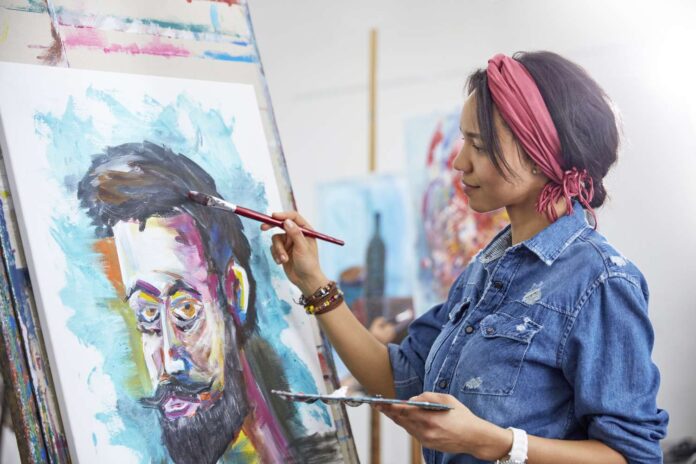Engaging in art and craft as a hobby has numerous benefits for mental health. Here’s an exploration of how and why it is beneficial:
1. Stress Relief and Relaxation
- Art as a Meditative Practice: Engaging in creative activities such as painting, drawing, knitting, or sculpting allows individuals to enter a state of flow, where they are fully immersed in the task at hand. This mindfulness-like state helps to calm the mind, reduce anxiety, and distract from daily stressors.
- Lower Cortisol Levels: Studies show that creating art can lower cortisol levels (the stress hormone), which helps alleviate feelings of stress and tension.
2. Emotional Expression and Release
- Processing Emotions: Art provides a non-verbal outlet for expressing emotions. People often find it easier to express feelings of sadness, anger, or joy through art when words may not be enough. It serves as a safe space for releasing bottled-up emotions, helping to prevent mental health issues.
- Symbolic Representation: Creating artwork allows individuals to symbolically represent their emotions or experiences, making it easier to process complex feelings and gain clarity.
3. Boosts Self-Esteem and Confidence
- Sense of Accomplishment: Completing a piece of art, whether a painting or a handmade craft, fosters a sense of achievement. This boosts self-esteem and confidence, especially when the individual sees the tangible results of their effort.
- Learning and Growth: As people improve their artistic skills, they gain a sense of mastery, which can enhance overall self-worth and make them feel capable and productive.
4. Improves Focus and Cognitive Function
- Cognitive Stimulation: Activities like knitting, sculpting, or assembling crafts require focus, hand-eye coordination, and problem-solving skills. These activities keep the brain engaged and improve cognitive functions, which can also aid in reducing feelings of boredom and restlessness.
- Focus and Mindfulness: The process of working on intricate details in art can promote a form of mindfulness, training the brain to focus on the present moment and improving concentration over time.
5. Promotes Social Connections
- Community and Collaboration: Art and craft groups provide opportunities for social interaction. Engaging with others who share similar interests can enhance feelings of belonging and reduce loneliness. This can be especially beneficial for individuals who may otherwise feel isolated.
- Shared Experiences: Participating in art workshops, crafting circles, or online art communities allows for the sharing of ideas, feedback, and encouragement, which supports mental well-being.
6. Mental Resilience and Coping Skills
- Overcoming Challenges: Working through challenges in creative projects teaches patience and perseverance. This helps build mental resilience, which can be applied to handling real-life challenges.
- Coping Mechanism: Art serves as a therapeutic outlet during difficult times. For many, it becomes a way to cope with grief, trauma, or depression by allowing them to externalize their emotions in a constructive manner.
7. Encourages Playfulness and Creativity
- Playful Exploration: Art encourages the inner child, promoting a sense of playfulness, experimentation, and curiosity. This can reignite a joy for life, especially for individuals stuck in rigid daily routines or suffering from burnout.
- Stimulates Creativity: Regular engagement in artistic endeavors keeps the brain flexible and creative, which can improve problem-solving skills in other areas of life.
8. Fosters Mind-Body Connection
- Sensory Engagement: Many forms of art and craft, like pottery, knitting, or painting, engage the senses and connect the body to the creative process. This can lead to enhanced awareness of the present moment, helping to ground the mind.
- Physical Benefits: Certain crafts like knitting, crocheting, or pottery involve repetitive hand movements, which can have calming effects similar to meditation, improving fine motor skills and dexterity.
9. Escape from Technology Overload
- Digital Detox: Many people spend their days surrounded by technology, leading to digital fatigue. Engaging in hands-on crafts or painting provides a break from screens and offers a tactile, more personal form of engagement.
- Mindful Engagement: Crafting encourages a slower, more thoughtful pace compared to the fast-paced, reactive nature of digital tasks, allowing the mind to rest and recharge.
10. Therapeutic Applications
- Art Therapy: Art is used as a formal therapeutic tool in many mental health practices, known as art therapy. This practice helps individuals process trauma, manage mental health conditions like depression or PTSD, and improve overall emotional well-being.
- Non-Judgmental Expression: Since art is subjective, there’s no “right” or “wrong” way to create, which removes the pressure of performance and encourages free expression without judgment or fear of failure.
Conclusion
Incorporating art and craft into daily life not only offers an enjoyable and fulfilling hobby but also provides significant mental health benefits. Whether you’re painting, knitting, or crafting, these activities help nurture emotional balance, foster creativity, and build resilience, making them valuable tools for managing mental well-being.



